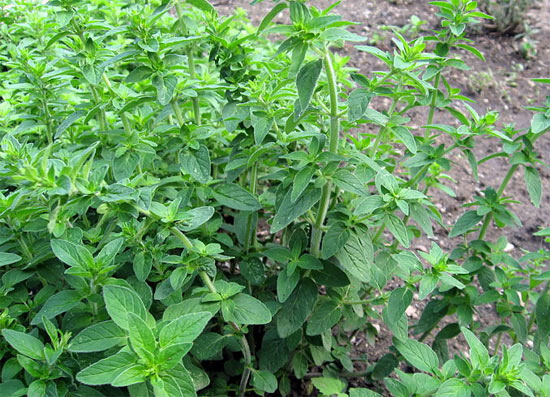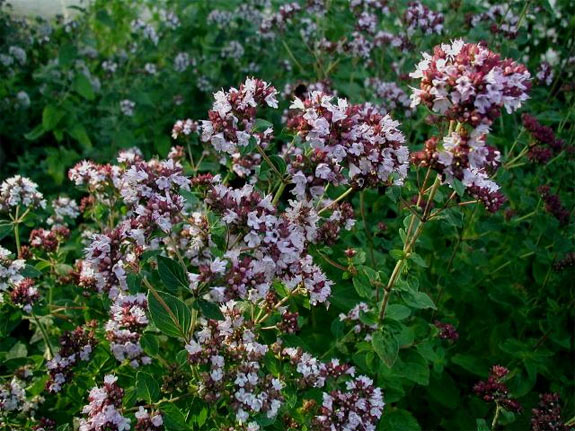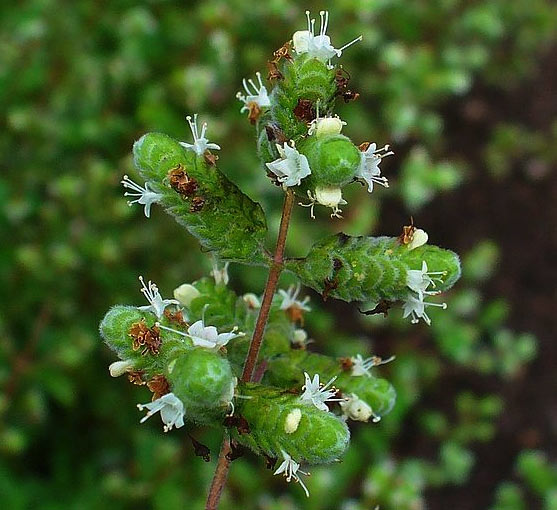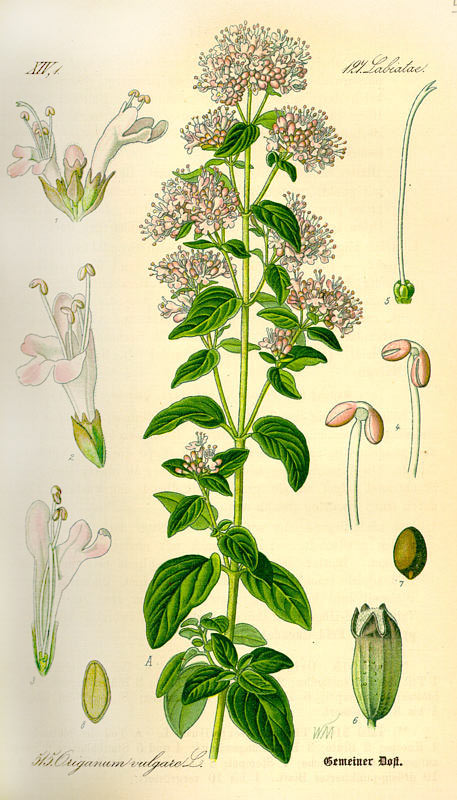There seems to be much confusion over the use of the words "oregano" and "marjoram". Sometimes they refer to the same plant, and sometimes not. Add to this the existence of Mexican, Greek, and Spanish oreganos and the confusion becomes even deeper. Let's see if we can sort out some of the confusion.
Oregano (Origanum vulgare) has purplish-pink flowers and is a bit stronger than sweet marjoram (Origanum marjorana). This has a smaller, neater, bushy habit, with grayish green slightly fuzzy leaves and white flowers. Both flower in summer, but marjoram has a longer season. Both are native to Greece and the Mediterranean regions.
Mexican oregano (Lippia graveolens) has a stronger flavor than regular oregano. It's also known as Mexican marjoram and Mexican wild sage. If your recipe calls for Mexican oregano it's best not to substitute anything else because it has such a strong, unique flavor.
Spanish (Origanum vivens) and Greek (Origanum heraclites) oreganos are said to be very similar to regular oregano. Greek oregano generally has a stronger aroma to the fresh leaves, which may not affect it's flavor.
Oregano, also known as the "pizza herb", can be used fresh or dried and brings a Mediterranean tang to the bland flavor of chicken or pasta. Like basil, oregano has a natural affinity with tomatoes. It is one of the few herbs that's stronger when dried than fresh.
Appearance
Oregano is low-growing, but spreads quickly to form small circular clumps. It has oval leaves and white or pale pink flowers which bloom from June to September.
 Vegetative parts of Origanum vulgare. Image from Wikimedia.
Vegetative parts of Origanum vulgare. Image from Wikimedia.
 Origanum vulgare flowers are slightly pink. Image from Wikimedia.
Origanum vulgare flowers are slightly pink. Image from Wikimedia.
 Leaves of O. marjorana are a bit fuzzy. Image from Wikimedia.
Leaves of O. marjorana are a bit fuzzy. Image from Wikimedia.
 Flowers of O. marjorana are white, with prominent bracts underneath. Image from Wikimedia.
Flowers of O. marjorana are white, with prominent bracts underneath. Image from Wikimedia.
Varieties
Origanum vulgare - Also known as wild marjoram. This is found growing wild in Europe. It is distinguished by its reddish-brown stalks. Occasionally the upper leaves have a bronze tinge.
Origanum marjorana - Also known as sweet or knotted marjoram. Annual. Leaves are slightly larger and a bit fuzzy. Flowers are white.
Origanum onites - Also known as pot marjoram, Cretan oregano, and Turkish oregano. A true perennial. Leaves are smaller and more hart-shaped. Pale pink flowers. Flavor very strong.
Origanum aureum - Golden marjoram or golden oregano. Perennial. Has gleaming gold leaves which are sometimes dappled in appearance. It is a beautiful border plant and has pink flowers in summer.
Origanum vivens - Spanish oregano.
Origanum heraclites - Greek oregano.
Propagation
Oregano is propogated by seed or by root division. Since the roots grow just below the surface of the soil, it is easy to dig up the plants in the autumn by pulling apart or using a sharp knife.
Cultivation
Being a native of the Mediterranean, oregano likes a warm, sunny, sheltered spot. It also appreciates a fairly rich, loamy soil. Plant out at a distance of 10 inches apart - or closer if it is to be used as an edging herb. The plants tend to sprawl and will need cutting back and trimming during the summer.
Pests and Problems
Sweet marjoram (O. marjorana) does not survive severe frost in the winter. This is probably why it's a popular herb for Meditarranean cuisines, because it grows and survives well in that climate.
Harvesting and Storing
The flavor and aroma is in the leaves. These can be picked fresh and used at any time. The young top shoots are particularly appealing. The leaves dry very well. Pick them, if you can, just before the plant flowers when the volatile oil is at its peak. Cut the plant so that just over half of the stem is still growing. Spread the shoots for drying on a piece of screen in a warm, well ventilated place. Alternatively, you can tie them up with raffia in small bunches and hang from the ceiling. They will be dry after a week and should still look green. Some people like to store the whole sprig and just crumble the leaves when they are needed. The aroma of oregano is very intense when dried.
